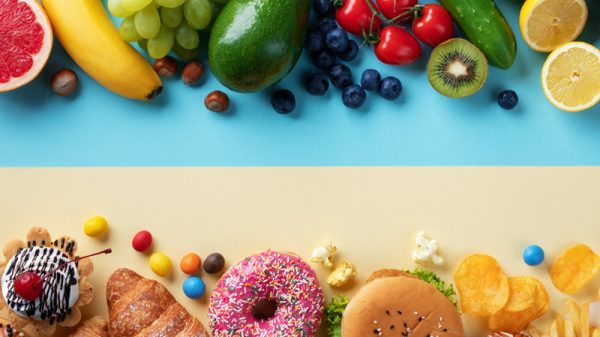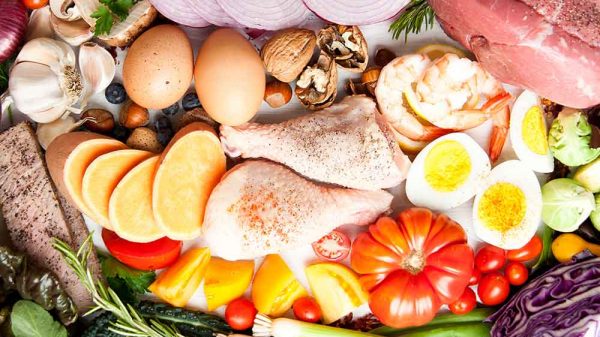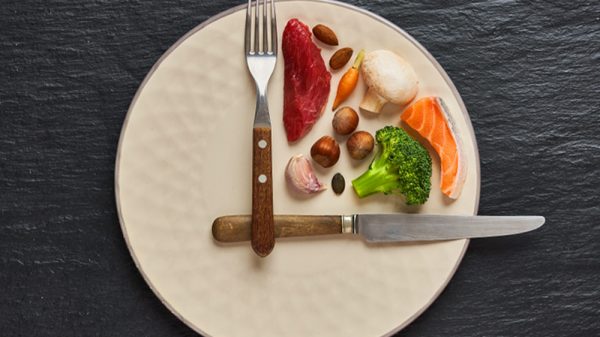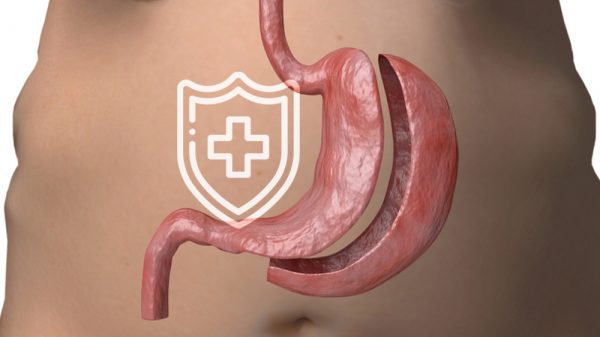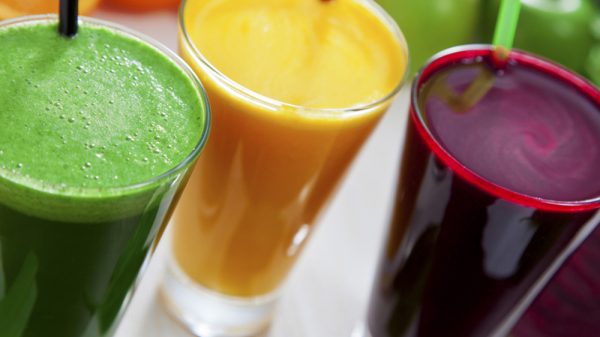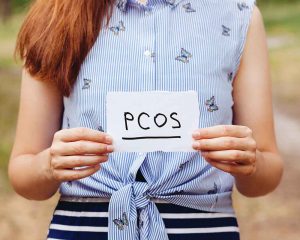We are all familiar with food cravings; those nightmarish, gnawing feelings that lead to late-night trips to the kitchen to demolish a whole bag of potato chips or an entire gallon of chocolate ice cream. Why do these cravings seem impossible to fight? And how can we stop them?
Controlling food cravings is key to successfully achieving weight loss goals, managing stress, and leading a healthy lifestyle. Find out tips for how to stop food cravings to promote a healthy diet for the reversal of the fatty liver disease.
Food Cravings: Why Do They Happen?
We all love comfort food: a juicy cheeseburger and fries, a big plate of pasta smothered in Bolognese sauce and parmesan cheese, fried chicken with macaroni and cheese, or cake with a side of ice cream.
These calorie-packed foods are quickly converted to energy, and whatever energy isn’t immediately used is put into storage, either as glycogen in our liver or fat stores throughout the body. Eating too many of these foods, over time, often leads to weight gain, insulin resistance, high blood pressure, type 2 diabetes, and fatty liver disease.
Food cravings are a part of the human experience and evolutionarily, our bodies are programmed to gravitate towards energy-dense foods high in fat and sugar. Our inclination towards high-fat, high-sugar foods and arguably addictive relationship with junk food at one point was an adaptive mechanism that promoted survival. When food was available, we would eat in surplus to raise the likelihood of survival until the next meal.
Today, our biological mechanism is the same. The only difference is that hundreds of years ago, food was not readily available. In the modern industrialized world, high-fat and high-sugar foods can be easily obtained from every grocery store, fast food restaurant, and gas station.
In short, we are naturally programmed to love sugary, fatty foods – a characteristic that is embedded in our DNA and beyond our control. It is impossible to stop “liking” high-fat, sugary, and salty foods.
So, it’s important to curb food cravings by addressing additional influential factors that are somewhat within our control.
Factors That Influence Food Cravings
Fighting food cravings is not about sheer willpower. Knowing triggers and factors for food cravings is key to making smart, strategic choices that help curb them.
Stress and Hormone Shifts
Cravings certain foods during periods of stress is a common phenomenon, often called “stress eating” or “emotional eating.” But why is this the case? Appetite is regulated in large part by hormones like ghrelin and leptin, as well as the stress hormone cortisol. Ghrelin is produced in the stomach when signifies hunger, while leptin is produced in the small intestine and decreases appetite. Cortisol is a hormone that the adrenal gland produces in stressful situations. During periods of chronic stress, cortisol levels can remain high and cause inflammation. Imbalances in hormones like ghrelin, leptin, and cortisol can influence cravings as well as appetite and weight gain.
A study published in Obesity and conducted by researchers at the University of Pennsylvania and Yale University sought to uncover the link between hormones, weight gain, and food cravings by examining 339 adults within a community. Researchers measured initial hormone and stress levels and conducted follow-up measurements after six months. Results showed that higher initial levels of chronic stress, cortisol, and insulin were significantly associated with weight gain at six months, while high levels of ghrelin increased food cravings. (1)
Exposure to Food Stimulus
Being exposed to food-related stimuli seems to increase the likelihood of experiencing a craving. Research shows that exposure to real food, as well as images of food, trigger the desire to eat certain foods. (2) This means that images of food outside of a restaurant, in a magazine, or on TV could trigger a food craving.
Addictive Element of Sugar
It’s no news that sugar is a biologically addictive substance to humans. In mouse models, research shows that sugar addiction produces withdrawal symptoms that are comparative to opiate withdrawal. In a study conducted at the Department of Psychiatry at the McKnight Brain Institute at the University of Florida, researchers determined sugar to play a pivotal role in encouraging binge-eating behavior and weight gain. (3)
The overconsumption of added sugar is also a major contributor to fatty liver disease and metabolic syndrome. Added sugars are rapidly digested and enter the bloodstream, markedly increasing your blood glucose levels. The pancreas must release insulin to signal the uptake of glucose into cells throughout your body. Excess glucose is then stored as fat, which over time, can lead to the accumulation of fat in the liver.
If you’re looking for how to stop craving sugar altogether, this is nearly an impossible task. To completely stop sugar cravings, it would require rewiring our brains and genetic code. However, it is possible to alter our responses to sugar cravings, in turn reducing their frequency and intensity. The first step to how to curb sugar cravings is being aware of sugar’s addictive quality. For more about this, keep reading in the “Tips for Curbing Food Cravings” section below.
Nutrient Deficiencies
If you’re experiencing a food craving, this may also be a sign that your body is trying to tell you something. However, in general, there is not overwhelming evidence to suggest that the body is able to fine-tune cravings according to specific nutrient deficiencies. For example, having a deficiency in one of the B vitamins does not necessarily mean you will experience cravings for vitamin B-rich foods like meat, brown rice, cheese, and beans. Biochemical processes for food metabolism and nutrient uptake are complex and may exhibit in unexpected ways.
For example, let’s take a look at tryptophan, one of the essential amino acids that comprise protein. Tryptophan has been shown to have a direct effect on food cravings, with a particularly strong connection to food intake. But low tryptophan does not exhibit as cravings for high-protein foods. A study published in Eating Behaviors evaluated the impact of tryptophan deficiency on the intake of sweet foods. Researchers found that among overweight adults, tryptophan resulted in a significant increase in sugar consumption. (4)
Tryptophan has a particularly profound impact on hunger because it plays a critical role in serotonin synthesis. Serotonin is a neurotransmitter that regulates mood, impulses, and appetite. A deficiency in tryptophan leads to lower serotonin levels that can, in turn, result in a strong desire for refined carbohydrates like sugar. (4)
On the whole, frequent cravings likely indicate that something about your diet is off-balance, and this may very well be due to a macronutrient or micronutrient deficiency.
Tips for Curbing Food Cravings
1. Drinking Enough Water
A lot of times, when we’re feeling ravenous, we are actually dehydrated. Dehydration can strike at unexpected times, resulting in weakness, fatigue, and low blood pressure. The sensation of thirst can be easily mistaken for low blood sugar or intense hunger.
When a craving strikes, first try drinking a large glass of water. Wait a few minutes and assess whether the craving persists. If the craving subsides even a little bit, this will help you to make better food choices.
2. Getting Adequate Protein
Protein takes the longest to pass through the digestive system and helps keep you feeling full for longer. The feeling of satiety has the potential to ward off food cravings and prevent overeating.
Science shows that protein is key for remaining satiated and staving off hunger pains. A study conducted by researchers at the Department of Nutrition and Exercise Physiology at the University of Missouri and the Department of Foods & Nutrition at the Ingestive Behavior Research Center at Purdue University evaluated the impact of protein intake on appetite. Results revealed that consuming high-protein meals may increase control over food intake. (5)
As discussed above, amino acids like tryptophan may play a role in helping your body regulate hunger and cravings. Regularly consuming high-quality protein will help ensure that you are getting optimal ratios of amino acids. Try incorporating at least one form of protein for each meal. For example, a nonfat Greek yogurt at breakfast; black beans and nuts at lunch; and salmon at dinner.
3. Regulating Stress Levels
A certain level of stress is unavoidable. However, utilizing tactics for reducing stress can help manage your cortisol levels and lead to less intense cravings.
When stressed, many of us tend to reach for high-fat, sugary comfort foods like doughnuts, pasta, and cheeseburgers. Try to steer away from foods as an outlet for stress, and instead aim to engage in other stress-relieving activities.
Here are a few examples of stress-relieving strategies:
- Getting enough sleep: This cannot be overemphasized. When sleep-deprived, none of the body’s mechanisms are working as well as they should be and the body is unable to effectively handle stress. This leads to exhaustion and low energy, which can often be mistaken for hunger. As is the case with dehydration, sometimes we misinterpret our bodies’ signals for sleep or water as hunger.
- Being mindful: Take a few minutes each day to check in with yourself and evaluate your stress level. If you are aware of any stress you’re experiencing, this helps you distinguish between stress cravings and actual hunger, so you can make healthier food choices.
- Physical activity: Being active is an excellent way to both relieve stress and distract from cravings. Going for a quick jog or walk, dancing, or going to a yoga class are great ways to lower cortisol and feel more relaxed.
4. Don’t Deprive Yourself
Forbidding yourself to touch sweets and high-fat foods is a strategy that can backfire. The deprivation mindset can lead to an irresistible craving.
The same goes for an “all-or-nothing” mindset. Often, when someone adopts this mindset, having unhealthy food is viewed as a failure. This, in turn, can lead to overindulgence and binge-eating patterns.
Instead, on occasion, allow yourself to have a treat. Giving yourself a room in your diet to eat a chocolate chip cookie, a slice of pizza, or fries on occasion will help banish the psychological dynamics associated with deprivation. The key to having treats is to consume them in moderation and avoid overeating. For example, have one cookie instead of five; eating two servings of potato chips instead of the entire bag; having one slice instead of a whole pizza.
5. Breaking the Addiction to Sugar
Due to the notoriously addictive nature of sugar, cutting back on sugar is one of the hardest diet changes to make. As mentioned above, it is nearly impossible to stop sugar cravings altogether. The key to reducing sugar cravings is by reducing sugar intake.
Eating sugar kickstarts a positive feedback loop. The more sugar we eat, the more sugar we want. Indulging in sugar during one meal increases cravings during the next meal. Sugar targets the pleasure centers of the brain and hijacks the reward system by providing a small dopamine high, which causes us to continue reaching for more sugar.
Cutting back on sweet foods until sugar intake is minimal will release the brain from this vicious cycle. It’s true that the less sugar you eat, the easier it is to control cravings.
Do not try to completely eliminate sugar from your diet from one day to the next. Instead, aim to slowly reduce your intake and start with small changes.
Here are a few examples of small changes you can make, as you work towards cutting out sugar:
- Cut out daily consumption of soft drinks, and instead save them for special occasions or the occasional treat.
- Replace sugar in your coffee with a sugar-free sweetener like Stevia or erythritol.
- Break the habit of having dessert every night, reserving sweet after-dinner foods for the weekend or holidays.
- Cut out processed and packaged snack foods that contain an unexpectedly high amount of sugar like granola bars, snack bars, and cereals.
6. Consuming a Balanced Diet
As explained above, food cravings may also be a result of nutrient deficiencies. When eating a varied and balanced diet that’s rich in whole foods, nutrient deficiencies and imbalances are less likely. When striving for balance, make sure you hit all of the following food categories:
- Fruits and veggies: Eating a variety of fruits and veggies ensures that you’re getting nutrients like fiber, vitamin C, vitamin A, phosphorus, potassium, and polyphenols that exhibit antioxidant activity. Examples of health-promoting fruits and veggies include apples, oranges, blueberries, blackberries, bananas, avocado, kale, broccoli, cauliflower, and carrots.
- Whole grains: Eating plenty of whole grains affords protein, fiber, B vitamins, copper, and zinc. Try adding quinoa, oats, and brown rice to your diet.
- Nuts, beans, and seeds: Nuts, beans, and seeds add lots of fiber, protein, B vitamins, vitamin E, magnesium, and selenium to your diet. Great options include walnuts, almonds, pecans, black beans, lentils, pumpkin seeds, and sunflower seeds.
- Meats: Meats provide all essential amino acids in optimal ratios, as well as vitamin D and vitamin B12. When it comes to chicken and beef, stick to lean, unprocessed cuts of meat. On the other hand, fatty fish like salmon are a great seafood option that is rich in omega-3 fatty acids.
- Low-fat dairy: Low-fat dairy, like meat, provides all essential amino acids in optimal ratios, as well as vitamin D and calcium. Dairy also contains probiotics for digestion. Choose low-fat dairy products like yogurt, cheese, and milk.
7. Satisfying Your Cravings with Healthy Substitutes
The issue with cravings is that we usually crave junk food that’s bad for us. If cravings for carrots or spinach were common, food cravings wouldn’t be a problem! Sometimes, the key to dealing with cravings is not fighting them but working with them. Luckily, there are ways to satisfy cravings without jeopardizing your diet plan.
- Desserts: If you’re craving sugar, a piece of fruit may do the trick. Particularly sweet fruits include pineapple, grapes, and dates. Or, healthy alternatives to your favorite desserts may satisfy your sweet tooth. Look for recipes that substitute dates for sugar, ground nuts for refined flour, and avocado for fat. Check your local grocery stores for healthier alternatives to ice cream, like sugar-free coconut milk ice cream.
- Carbs: If you’re craving carbs, reach for whole grains like whole-grain breads, quinoa, brown rice, and oatmeal instead of refined grains. Another option is to roast starchy vegetables, which satisfy your carb craving while providing a wealth of extra nutrients.
- Protein: If you’re craving protein, you may be hungry for savory meals like burgers or steak. The key to satisfying a protein craving is to choose lean, unprocessed proteins that spare you of sodium, artificial additives, and saturated fat.
- Fat: If you’re craving fat, you’re likely looking for heavy fried foods or creamy dairy products like cheese. Avocado and coconut milk are excellent substitutes for full-fat dairy products. Just used coconut milk sparingly, since it is high in medium-chain saturated fats. Though medium-chain saturated fats are healthier than those found in animal products, it’s still a good idea not to overdo it.
- Salt: If you’re craving salty foods, taste profiles that may satisfy a salt craving include spicy, tangy, and sour. Adding hot sauce to a dish may similarly satisfy a salt craving. Indulging a salt craving a little bit from time to time is ok too, just don’t consume too much. Kimchi and sauerkraut are healthy, low-calorie options that also support gut health. Eating some pickles may give you the salty flavor fix without the calories and fat.
8. Knowing How to Navigate Restaurants
Navigating restaurants and stores can be particularly challenging because of the sensory display of unhealthy foods, including visuals and scents.
- Don’t go to a restaurant starving. This can increase your reaction to food stimuli and increase the likelihood of ordering unhealthy foods to satisfy cravings. Always eat a high-protein snack or small meal before heading out to a restaurant. Not only will this stave off cravings, but it will also help you refrain from overeating.
- Evaluate the menu. Read through the menu and ingredients in the meal. If a sandwich comes with fries, ask if you can substitute a side salad instead. If you’re ordering an entrée salad, ask for a dressing that is a vinaigrette, instead of a cream-based dressing.
- Don’t clear your plate. Restaurant portions are usually huge and provide more calories than we actually need. If you’re full, package the rest in a box so you can eat it for another meal.
Similar ideas apply to gas stations and vending machines. In certain situations, such as when traveling, sometimes the only food available is at a gas station or vending machine. Just because hot dogs, crackers, candy, and cookies are in sight doesn’t mean you should give in to cravings and buy them. Instead, evaluate your options and stick to healthier choices like popcorn and trail mix.
9. Distraction
Try not to respond to a food craving as soon as it sets in. In many cases, a craving may pass in just 10 minutes or so. During these 10 minutes, actively try to distract yourself to divert your focus away from the craving. For example, you could go for a walk, call a friend, or turn on a funny show. Even playing a game on your smartphone could allow your mind to get involved in another activity for just long enough to allow the craving to pass.
10. Having Snacks on Hand
Having healthy snacks on hand can prepare you to stave off cravings. For example, imagine you are hungry and walking past a favorite food chain on the way home from work – a temptation that’s pretty difficult to resist. However, if you have a high-protein snack in your bag to quell hunger until you get home, there’s a higher likelihood of skipping fast food.
Here are a few examples of portable, protein-packed snacks:
- Trail mix
- Apples with peanut butter
- Low-fat cheese
- Peanut butter sandwich on whole-grain bread
Though whole foods are always the best, in a pinch, it’s helpful to have a protein bar in your bag. Before purchasing a protein bar, check the nutrition label and ingredients list to make sure there are no added sugars or preservatives.
One word of caution: Avoid mindlessly snacking on unhealthy foods while watching TV or passing through the kitchen. These seemingly small snacks can quickly add up to large amounts of calories, sugar, and fats.
Conclusion
Curbing food cravings is vital for maintaining a healthy weight and managing conditions like metabolic syndrome and fatty liver disease. Arming yourself with tools and information can help you fight food cravings, so you can feel in control of your food choices.
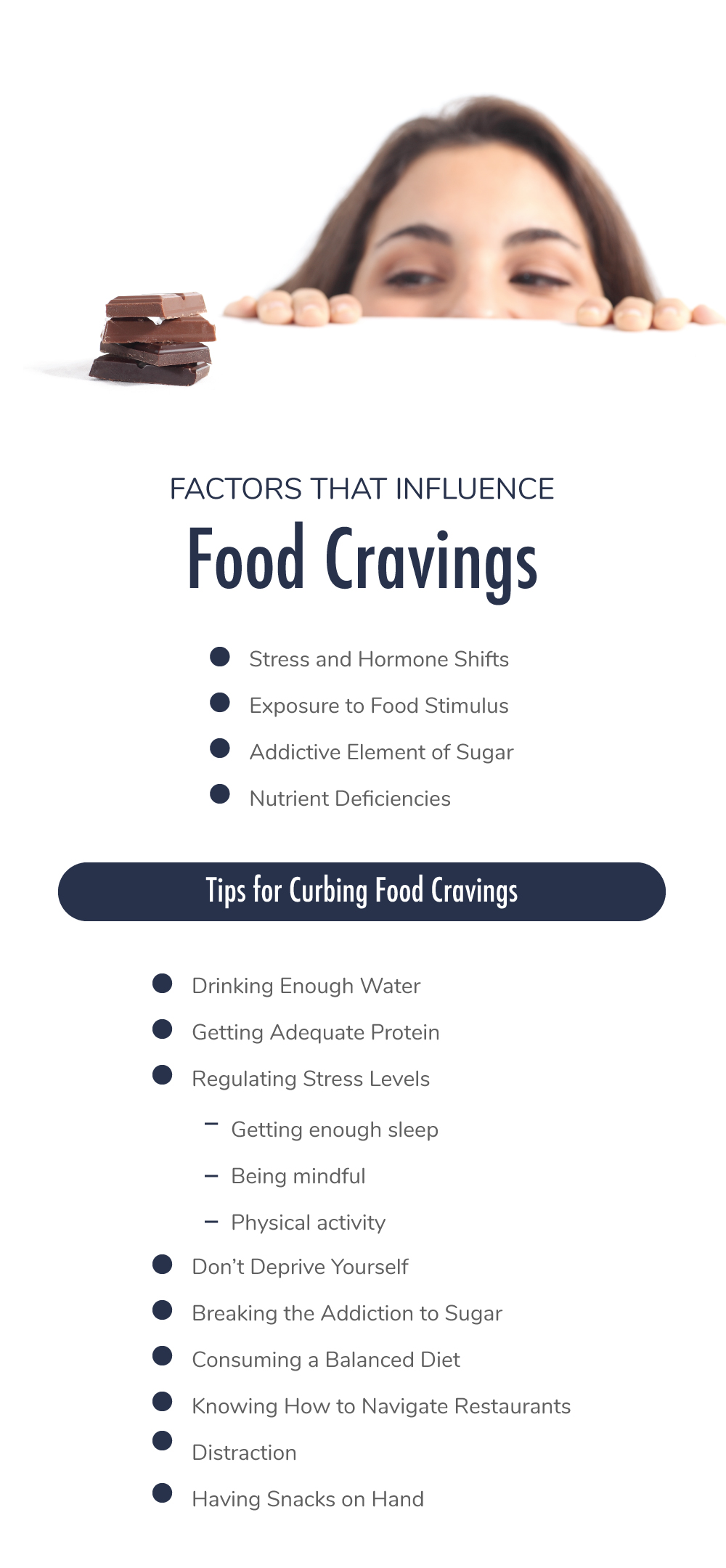
References:
(1) https://www.ncbi.nlm.nih.gov/pmc/articles/PMC5373497/
(2) https://www.ncbi.nlm.nih.gov/pmc/articles/PMC6042864/
(3) https://www.ncbi.nlm.nih.gov/pubmed/22231826
